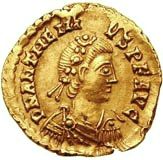Anthemius
Anthemius attempted to solve the two primary military challenges facing the remains of the Western Roman Empire: the resurgent Visigoths, under Euric, whose domain straddled the Pyrenees; and the unvanquished Vandals, under Geiseric, in undisputed control of North Africa.
Anthemius belonged to a noble family, the Procopii, which gave several high officers, both civil and military, to the Eastern Roman Empire.
[4] In 453, he married Marcia Euphemia, daughter of the Eastern emperor Marcian (450–457); after the marriage, he was elevated to the rank of comes and sent to the Danubian frontier with the task of rebuilding the border defences, neglected after Attila's death in 453.
Therefore, both empires had no emperor, and the power was in the hands of the Western generals, Ricimer and Majorian, and the Eastern Magister militum, the Alan Aspar.
[7] The newly elected Eastern Roman emperor, Leo I the Thracian, had a major foreign affairs problem: the Vandals of King Geiseric and their raids on the Italian coasts.
In 470 the consuls were Messius Phoebus Severus, Anthemius' old friend and fellow student at Proclus' school, and the Magister militum per Orientem Flavius Iordanes.
The poet Sidonius Apollinaris arrived in Rome on the occasion of the wedding at the end of 467 and described the celebrations in which all social classes were involved; he also hints that Alypia might have not liked her husband, a barbarian.
A fleet consisting of upwards of one thousand vessels was collected to transport the combined Eastern-Western-Illyric army, and while most of the expenses were paid for by the Eastern Empire, Anthemius and the Western treasury contributed to the costs.
Peter Heather considers this expedition to have been the final opportunity to restore the Empire, which from this point would now only control the Italian peninsula and Sicily.
[13] After the disastrous campaign in Africa, Anthemius concentrated on the second problem of his Empire, keeping under his control the Western provinces targeted by Visigothic expansion.
He turned to the reconquest of Gaul, occupied by Visigoths under the ambitious King Euric who had exploited the weak Roman control caused by political instability.
Anthemiolus moved from Arelate and crossed the Rhone river, but he was intercepted by Euric, who defeated and killed the Roman generals and pillaged the area.
[c] In order to obtain the support of the senatorial aristocracy, Anthemius conferred the rank of patricius on members of the Italian and Gallic governing class.
He introduced the practice, common in the East, of appointing even civilians to the patrician rank, and honoured so many members of the aristocracy with this title that it suffered a sort of inflation.
[17] Sidonius was so influential that he convinced the Emperor to commute the death penalty of Arvandus, the Praetorian prefect of Gaul who had allied himself with the Visigoths.
Anthemius had his mints (at Mediolanum, Ravenna and Rome) issue solidi depicting the two Emperors joining hands in a show of unity.
Anthemius, with the aristocracy and the people of the city, faced the Gothic magister militum and the barbarian units of the army, which included Odoacer's men.
Bilimer arrived in Rome but died trying to prevent Ricimer entering the centre of the city from the other side of the Tiber, through the Pons Aelius in front of the Mausoleum of Hadrian.
[24] Losing any hope of external help and pressed by the scarcity of food, Anthemius tried to rally, but his men were defeated and killed in great numbers.


